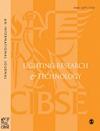In praise of persistence
IF 2.2
3区 工程技术
Q2 CONSTRUCTION & BUILDING TECHNOLOGY
引用次数: 0
Abstract
This issue of Lighting Research and Technology is devoted to the theme of ambient lighting, a topic driven largely by the work of Kit Cuttle. In my opinion, Kit Cuttle has been one of the foremost thinkers and educators in lighting for more than 50 years. I first met Kit in 1967, at the time he was working on the flow of light from windows, a topic that led to the concept of vector/ scalar ratio as a metric for modelling, one of the first attempts to quantify lighting characteristics beyond planar illuminance. In 1976, he emigrated to New Zealand, where he joined the Wellington Victoria University School of Architecture and thus began his career in lighting education, a career that has included teaching at the Lighting Research Center and at the University of Auckland and from which many students have benefited. Teaching has been one of Kit’s strengths. This is because he sees it as a two-way process. The students learn from him and he learns from the students. One thing that became apparent to him when teaching the design process was that students tended to adopt a technology-first approach. To Kit, this was wrong. He has always advocated that the first question to be addressed in any lighting design is what do you want to see? As a result, he has developed a series of simple devices for demonstrating the way in which the reflection characteristics of 3D objects and the luminous flux distribution around them interact to create a shadow pattern, a highlight pattern and a shading pattern. These are well explained in his book Lighting by Design. But this was not enough for him. The bigger question is: How can such knowledge be incorporated into a design method? The problem Kit identified is that conventional lighting design is dominated by the lumen method, a method that encourages a technology-first approach and that inevitably leads to a regular array of luminaires providing uniform illumination. Over the last decade, he has sought to change the primary function of interior lighting from lighting the task to lighting the space, from task lighting to ambient lighting. To achieve this calls for a new design method based on first stating what the lighting objectives are and then determining the luminous flux distribution needed to achieve those objectives. It is only at this point that the technology to be used is selected. The potential impact of this Lighting Objectives Design Procedure on lighting practice is huge. How has he achieved so much? I believe the answer is primarily through persistence, but also through openness and ingenuity. Throughout his career, he has persisted in thinking about how to make lighting better. Furthermore, he is open with his time and thoughts. He has a gift for listening, for observation and for asking significant questions. Finally, he is an ingenious fellow who can create thought experiments, develop devices and create systematic design procedures. The world of lighting has been lucky to have him.赞美坚持不懈
这一期的《照明研究与技术》致力于环境照明的主题,这一主题在很大程度上是由Kit Cuttle的工作推动的。在我看来,50多年来,Kit Cuttle一直是照明领域最重要的思想家和教育家之一。我第一次见到Kit是在1967年,当时他正在研究窗户的光流,这个主题导致了矢量/标量比的概念,作为建模的度量,这是第一次尝试量化平面照度以外的照明特性。1976年,他移民到新西兰,在那里他加入了惠灵顿维多利亚大学建筑学院,从而开始了他的照明教育职业生涯,他的职业生涯包括在照明研究中心和奥克兰大学任教,许多学生从中受益。教学一直是基特的强项之一。这是因为他认为这是一个双向的过程。学生向他学习,他也向学生学习。在教授设计过程时,他发现学生们倾向于采用技术优先的方法。对基特来说,这是错误的。他一直主张在任何灯光设计中首先要解决的问题是你想看到什么?因此,他开发了一系列简单的装置,用于演示3D物体的反射特性及其周围光通量分布相互作用产生阴影图案,高光图案和阴影图案的方式。这些在他的书照明设计中有很好的解释。但这对他来说还不够。更大的问题是:如何将这些知识整合到设计方法中?Kit发现的问题是,传统的照明设计是由流明法主导的,这种方法鼓励技术优先的方法,不可避免地导致灯具的常规阵列提供均匀的照明。在过去的十年里,他试图改变室内照明的主要功能,从照亮任务到照亮空间,从任务照明到环境照明。为了实现这一目标,需要一种新的设计方法,首先说明照明目标是什么,然后确定实现这些目标所需的光通量分布。只有在这一点上,才选择要使用的技术。这个照明目标设计程序对照明实践的潜在影响是巨大的。他是如何取得如此大的成就的?我相信答案主要是通过坚持,但也要通过开放和独创性。在他的整个职业生涯中,他一直坚持思考如何使照明变得更好。此外,他对自己的时间和思想是开放的。他有倾听、观察和提出重要问题的天赋。最后,他是一个有独创性的人,可以创造思想实验,开发设备,创造系统的设计程序。灯光界有幸拥有他。
本文章由计算机程序翻译,如有差异,请以英文原文为准。
求助全文
约1分钟内获得全文
求助全文
来源期刊

Lighting Research & Technology
工程技术-光学
CiteScore
5.40
自引率
16.00%
发文量
69
审稿时长
>12 weeks
期刊介绍:
Lighting Research & Technology (LR&T) publishes original peer-reviewed research on all aspects of light and lighting and is published in association with The Society of Light and Lighting. LR&T covers the human response to light, the science of light generation, light control and measurement plus lighting design for both interior and exterior environments, as well as daylighting, energy efficiency and sustainability
 求助内容:
求助内容: 应助结果提醒方式:
应助结果提醒方式:


